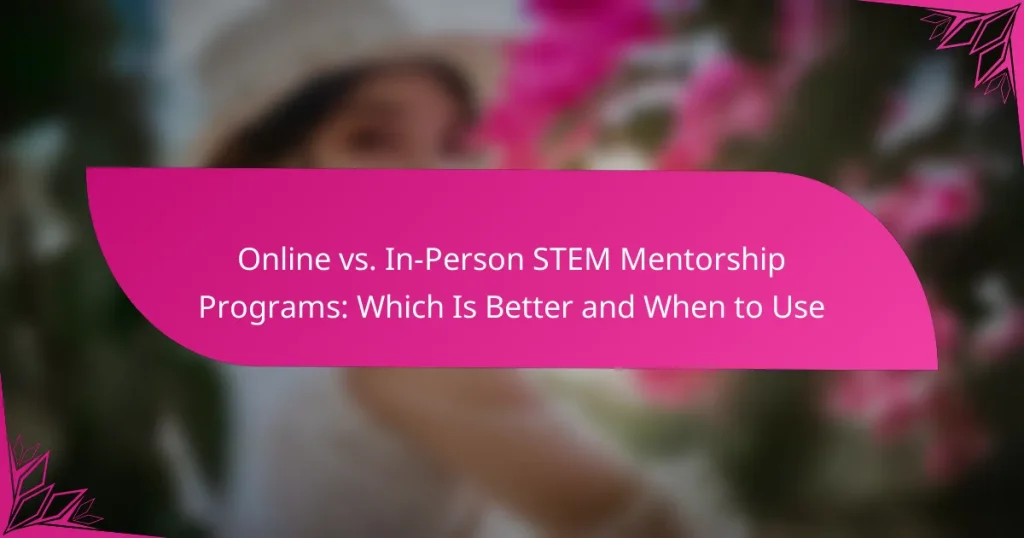Choosing between online and in-person STEM mentorship programs depends on individual needs and circumstances. Online programs provide flexibility and access to a wider network, making them ideal for those facing geographical or time constraints. In contrast, in-person mentorship fosters deeper connections and hands-on experiences, enhancing the overall learning journey. Understanding the strengths of each format can help mentees make informed decisions about their mentorship paths.

What are the benefits of online STEM mentorship programs?
Online STEM mentorship programs offer significant advantages, including flexibility, broader networking opportunities, and cost savings. These programs leverage technology to connect mentors and mentees, making it easier to access expertise and resources from anywhere.
Flexibility in scheduling
One of the primary benefits of online STEM mentorship is the flexibility it provides in scheduling sessions. Participants can arrange meetings at times that suit their availability, which is particularly beneficial for those balancing work or study commitments. This adaptability often leads to more consistent engagement and better outcomes.
For example, a mentor based in a different time zone can easily accommodate a mentee’s schedule, allowing for regular interactions without the constraints of geographical limitations. This flexibility can enhance the overall mentorship experience.
Access to a wider network
Online STEM mentorship programs enable participants to connect with a diverse range of mentors and peers from various locations and backgrounds. This expanded network can provide unique insights and perspectives that may not be available locally. Mentees can learn from experts in specific fields, regardless of their physical location.
For instance, a student in a small town can access mentorship from industry leaders in major cities or even internationally, enriching their learning experience and career prospects. This global reach fosters collaboration and innovation in STEM fields.
Cost-effectiveness
Online mentorship programs are often more cost-effective than in-person alternatives. They eliminate travel expenses and venue costs, making them accessible to a wider audience. Many online programs also offer free or low-cost options, further reducing financial barriers.
For example, a mentee might save on transportation and accommodation costs associated with attending in-person workshops or conferences. This affordability can encourage more individuals to seek mentorship, ultimately benefiting the STEM community.
Variety of resources available
Online STEM mentorship programs typically provide access to a wide array of resources, including webinars, articles, and interactive tools. Participants can utilize these materials to enhance their learning and development, often at their own pace. This variety caters to different learning styles and preferences.
Additionally, many platforms offer forums or discussion groups where mentees can engage with peers and mentors, fostering a collaborative learning environment. This abundance of resources can significantly enrich the mentorship experience and support ongoing professional growth.

What are the benefits of in-person STEM mentorship programs?
In-person STEM mentorship programs offer unique advantages that can significantly enhance the learning experience. These benefits include personalized interaction, hands-on experience, and stronger relationship building, all of which contribute to a more effective mentorship dynamic.
Personalized interaction
In-person mentorship allows for direct, face-to-face communication, which can lead to more tailored guidance. Mentors can assess a mentee’s body language and reactions in real-time, enabling them to adjust their teaching methods accordingly.
This personalized interaction fosters a supportive environment where mentees feel more comfortable asking questions and expressing concerns. Such engagement can lead to deeper understanding and retention of complex STEM concepts.
Hands-on experience
Hands-on experience is a hallmark of in-person STEM mentorship programs, as they often include practical activities and experiments. This experiential learning allows mentees to apply theoretical knowledge in real-world scenarios, enhancing their skills and confidence.
For instance, a mentee working on a robotics project can physically manipulate components and troubleshoot issues with immediate feedback from their mentor. This type of learning is often more impactful than virtual simulations.
Stronger relationship building
Building strong relationships is easier in person, where informal interactions can occur naturally. These connections can lead to lasting professional networks, which are invaluable in STEM fields where collaboration is key.
Moreover, mentors and mentees who engage in social activities or group projects together often develop a sense of camaraderie. This bond can motivate mentees to pursue their goals more vigorously and seek further guidance as they advance in their careers.

When should you choose online STEM mentorship?
Online STEM mentorship is ideal when geographical barriers, time constraints, or a preference for digital tools come into play. It allows for flexible scheduling and access to a broader range of mentors, making it suitable for diverse needs.
Geographic limitations
Online mentorship eliminates geographic barriers, allowing participants to connect with mentors from anywhere in the world. This is particularly beneficial for those in remote areas or regions with limited access to STEM professionals. For example, a student in a rural location can easily engage with an expert based in a major city or even another country.
Time constraints
Flexibility in scheduling is a significant advantage of online mentorship. Participants can often arrange meetings at times that suit their busy lives, whether that means evenings, weekends, or during breaks. This adaptability can be crucial for students balancing studies, work, or family commitments.
Preference for digital tools
For those comfortable with technology, online mentorship can leverage various digital tools to enhance learning. Platforms like video conferencing, collaborative software, and online resources can facilitate effective communication and resource sharing. If you prefer using apps and online platforms for learning, online mentorship may be the better choice.

When should you choose in-person STEM mentorship?
In-person STEM mentorship is ideal when you seek hands-on guidance, collaborative opportunities, and local community involvement. These factors can significantly enhance learning experiences and foster deeper connections between mentors and mentees.
Desire for direct guidance
In-person mentorship allows for immediate feedback and personalized instruction, which can be crucial for mastering complex STEM concepts. The ability to ask questions and receive answers in real-time fosters a more dynamic learning environment.
For example, a mentee struggling with a coding project can sit down with their mentor to troubleshoot issues together, leading to quicker resolutions and a better understanding of the material.
Need for collaborative projects
Working on projects together is often more effective in person, as it allows for spontaneous brainstorming and problem-solving. Collaborative projects can benefit from the physical presence of team members, facilitating communication and teamwork.
Consider a robotics competition where team members must build and program a robot. Being together in a workshop can enhance creativity and efficiency, as participants can quickly share ideas and make adjustments on the spot.
Local community engagement
In-person mentorship often involves engaging with local organizations, schools, or events, which can enrich the learning experience. This connection to the community can provide additional resources and networking opportunities that online programs may lack.
For instance, participating in local STEM fairs or workshops can help mentees build relationships with industry professionals and peers, fostering a sense of belonging and motivation within their community.

What criteria should you consider when selecting a STEM mentorship program?
When selecting a STEM mentorship program, consider factors such as program reputation, mentor qualifications, and cost structure. These elements will help you determine which program aligns best with your goals and needs.
Program reputation
The reputation of a STEM mentorship program can significantly influence its effectiveness. Look for programs with positive reviews, testimonials, and a track record of successful alumni. Researching online forums and social media can provide insight into the experiences of past participants.
Consider the program’s affiliations with reputable organizations or educational institutions, as this can enhance credibility. A well-regarded program often attracts high-quality mentors and offers valuable networking opportunities.
Mentor qualifications
Assessing mentor qualifications is crucial for a successful mentorship experience. Look for mentors with relevant academic backgrounds and professional experience in STEM fields. Their expertise should align with your specific interests and goals.
Additionally, consider the mentor’s mentoring style and availability. A good mentor should be approachable, supportive, and willing to invest time in your development. It’s beneficial to find a mentor who not only has the right qualifications but also matches your learning preferences.
Cost structure
The cost structure of a STEM mentorship program can vary widely. Some programs may charge a flat fee, while others might have tiered pricing based on the level of mentorship or resources provided. Be sure to understand what is included in the fee, such as access to materials or networking events.
Look for programs that offer scholarships or financial aid options if cost is a concern. Weigh the potential return on investment against the program’s benefits to ensure you make a financially sound decision.

What are the emerging trends in STEM mentorship?
Emerging trends in STEM mentorship focus on leveraging technology and diverse formats to enhance learning experiences. Online platforms and hybrid models are increasingly popular, allowing for greater accessibility and flexibility in mentorship arrangements.
Increased Use of Online Platforms
Online mentorship platforms are becoming more prevalent, enabling mentors and mentees to connect regardless of geographical barriers. These platforms often provide tools for communication, project collaboration, and resource sharing, making it easier to engage in meaningful mentorship.
For example, platforms like MentorCity and LinkedIn offer structured environments for mentorship, allowing users to set goals and track progress. This can be particularly beneficial for students in remote areas or those with busy schedules, as they can access mentorship from anywhere at any time.
Hybrid Mentorship Models
Hybrid mentorship models combine online and in-person interactions, offering the best of both worlds. This approach allows for initial online meetings to establish rapport, followed by face-to-face sessions for deeper engagement and hands-on experiences.
Such models can be particularly effective in STEM fields, where practical skills are essential. For instance, a mentor might guide a mentee through a coding project online, then meet in person for a workshop or lab session to apply those skills in a real-world context.
Focus on Diversity and Inclusion
There is a growing emphasis on diversity and inclusion within STEM mentorship programs. Organizations are increasingly recognizing the importance of mentoring underrepresented groups, which can lead to a more equitable and innovative workforce.
Mentorship programs are now actively seeking to match mentors and mentees from diverse backgrounds, helping to break down barriers and foster a more inclusive environment. This trend not only benefits individuals but also enhances the overall quality of STEM fields by incorporating a wider range of perspectives and ideas.


